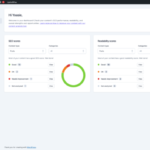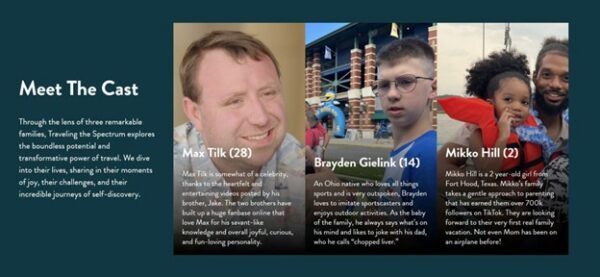Stuart Butler is a trained rocket scientist turned content marketing rock star.
Though the career as a rocket scientist didn’t stick, he applied what he learned to a 20-plus-year career in marketing. Now, as chief marketing officer of Visit Myrtle Beach, Stuart wants to disrupt not only the destination marketing space but ALL of marketing.
And it seems to be working.
Stuart and his team created Traveling the Spectrum, a heartwarming, unscripted six-part video series following three families living with autism as they go on vacation (in Myrtle Beach, of course).
A deal with a well-known streaming service is expected to be announced soon. But for now, you can watch the trailer embedded here.
From the storytelling to the marketing strategy to the distribution plan, Stuart is doing something he believes few marketers are willing to do: Set their brand ego aside, stop controlling the message, and realize that great content always puts authenticity first.
You can watch my interview with Stuart here or read on to learn more about the project and his marketing philosophy.
Leaning into the media company model
“We want to try things that people haven’t tried before and do them in a new way,” Stuart says.
When Stuart started three years ago, he knew times were changing. Destination marketing organizations like Visit Myrtle Beach spent most of their budget on paid media. But, as he learned running a B2B agency in the hotel space, paid media was becoming less effective because consumers increasingly rejected advertising, starting with adding pop-up blockers to their browsers. On top of that, platforms like Google and Facebook had increasingly become the gatekeepers of content and raised their advertising prices.
But Stuart had a plan. He believed the best path forward was building their audiences through owned media — what he calls “branded entertainment.”
“Instead of selling to people, we wanted people to make their own decisions, have their own thoughts and feelings; to influence their behaviors so that they chose to come to Myrtle Beach as a destination instead of being told to [come],” Stuart says.
With that philosophy in mind, Stuart tackled the creation of a reality cooking competition show called “Chef Swap at the Beach” to highlight the 2,000 restaurants and amazing culinary scene in Myrtle Beach. The show featured two local chefs who swapped kitchens and created a surprise meal for a panel of judges. It now airs on the Cooking Channel and other streaming networks and has just released its second season.
Stuart says “Chef Swap at the Beach” was more successful at elevating the Visit Myrtle Beach brand in terms of media coverage and audience value than any of its paid marketing projects to date.
They also learned that by following two simple rules — entertain and help the audience — people will not only listen, but they will tell their friends and come back.
The success of Chef Swap helped Stuart get buy-in for other projects, but it still took a while. He spent the first six to 12 months on the job educating his co-workers and Visit Myrtle Beach’s board of directors on the changing media landscape. (This is where he says his background in physics helped, as he knew how to deconstruct a problem to the first principles.) He knew it was a big leap to convince them to rely less on paid media and invest in owned media projects.
“We really were very methodical in building the bricks and the scaffolding around the argument,” Stuart says. “We wanted to do it in a way that was comfortable for people, that was digestible.”
So, he started by asking them to commit 10% of the budget to a few test projects for owned media. It worked. And it helped Stuart get buy-in for his passion project, Traveling the Spectrum, which he calls the culmination of a three-year strategy to move from conventional marketing to a more progressive view.
Storytelling is the heart of marketing
Myrtle Beach is best known for its 60 miles of beautiful sunny beaches, amazing attractions, and award-winning restaurants. But people may not know that the area is a pioneer in autism-friendly travel.
In 2016, Champion Autism Network (CAN) declared its hometown of Myrtle Beach as the first autism-friendly certified destination in the United States. The Myrtle Beach International Airport, in conjunction with CAN, opened the Quiet Room, where families can soothe a child during a meltdown. It became a model for airports around the world.
Additionally, Stuart and his team partnered with CAN, Autism Travel Club, and TravelAbility to create The Beach is for everyBODY Sensory-Friendly Pledge. Dozens of hotels, restaurants, and attractions signed it, agreeing to train their frontline workers in identifying the challenges of people with neurodiversity and how to accommodate them. Stuart’s team created a special area on the Visit Myrtle Beach website to share their resources for families traveling with members on the spectrum.
With that groundwork laid, Stuart’s team set out to create awareness that Myrtle Beach is an inclusive, welcoming place to visit for autistic families and people with neurodiversity. Inspired by the reality show Love on the Spectrum, the Myrtle Beach marketers came up with the concept to highlight the good, the bad, and the meltdowns experienced by these families with members on the autism spectrum.
Stuart had a clear vision for the project. “We don’t want this show to be about Myrtle Beach. We want it to be about the challenges of traveling with autism. We don’t want to be saying to people, ‘Come to Myrtle Beach because we’re sensory-friendly.’
“We want to be spreading the message that 87% of families who have a kid on the spectrum don’t travel. And we think that’s an injustice that needs to be solved. We’re going to have more impact on the world if it doesn’t look to be a promotion from a destination.”
Stuart tapped the Philadelphia-based The Workshop Content Studios, which had worked on Chef Swap, to develop Traveling the Spectrum. The series takes viewers behind the scenes and showcases the unique experiences of exploring sensory-friendly travel at Myrtle Beach. The show includes three families — the Tilks, including Max, age 28, from Michigan; the Gielinks, including Brayden, age 14, from Ohio; and the Hills, including Mikko, age 2, from Texas.

“It’s going to change the world. It’s going to change the way people see autism. It’s going to show that there are degrees of the spectrum,” Stuart says. “It’s going to show that people can be a part of the solution by showing a little more empathy and a little more understanding to people who are different than themselves.
“And I think it’s something that the community in Myrtle Beach is going to be really proud of because it shows that we’re very welcoming and hospitable.”
Stuart’s team is also working on other innovative, non-promotional ways to tell the story that Myrtle Beach is an autism-friendly place. They worked with author Lynda Farrington Wilson on a children’s book — “Splish, Splash, Squawk! Finding Joy in a Sensory-Friendly Vacation.”

They also have a podcast, “Life’s a Beach … And Then You Die,” that tells stories of human experiences, including those on the autism spectrum. The multiplatform strategy ensures a consistent message. But to Stuart, it’s all about one thing.
“I believe that the marketers are storytellers. I believe that a job is to shine a light on the positive story that exists, whether it’s a business, a service, or whatever we’re trying to promote. And so, in this case, it’s really easy because we can tell real stories of real people.”
Measuring success
But how will Visit Myrtle Beach measure the impact of Traveling the Spectrum?
Stuart says he thinks Myrtle Beach will attract more than its fair share of travelers who will realize they can travel despite the challenges. And it seems to be working. Stuart says people are finding out organically that Myrtle Beach is behind the Traveling the Spectrum project and are spreading the word. The tight-knit autism community shares resources with each other.
“When you can sort of tap into an audience that is that communal, it sort of accelerates the adoption. And so, we’ve seen that word of mouth, which is always going to be the most powerful form of marketing,” Stuart says.
That word-of-mouth marketing appears on The Traveling Spectrum website, which shows that over 870,000 visitors support its message, just below its social-media share buttons.
 visitors support its message just below its social-media share buttons.” class=”wp-image-143306″>
visitors support its message just below its social-media share buttons.” class=”wp-image-143306″>Between YouTube, Facebook, and Instagram, the trailer for Traveling the Spectrum has been viewed more than 750,000 times. Media mentions have gone through the roof.
Stuart says looking at those core KPIs alone shows that the series is a home run even before it hits the streaming platform. And while he believes Traveling the Spectrum will result in a tangible increase in travel, especially for the most valuable first-time visitors, to Myrtle Beach, he thinks it will do something even better.
“It’s going to change the perception of who Myrtle Beach is. People are going to look at us in an entirely different light. It’s going to elevate our brand to this level that we’ve never seen before,” Stuart says.
“Some of that’s measurable, some of it’s not. But even before the show (has) launched, we’re very, very happy with the results we’ve gotten. And once it’s launched, I think it’s just going to be next level.”
If you’d like to help spread the word about the Traveling the Spectrum movement, visit the website, sign the pledge, and share across your social platforms (or through word of mouth).
HANDPICKED RELATED CONTENT:
Cover image by Joseph Kalinowski/Content Marketing Institute




